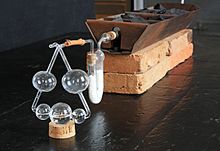 Global Information
Global InformationKaliapparat information

A kaliapparat is a laboratory device invented in 1831 by Justus von Liebig (1803–1873) for the analysis of carbon in organic compounds.[1] The device, made of glass, consists of a series of five bulbs connected and arranged in a triangular shape.
To determine the carbon in an organic compound with a kaliapparat, the substance is first burned, converting any carbon present into carbon dioxide (CO2). The gaseous products along with the water vapor produced by combustion are passed through the kaliapparat, which is filled with a potassium hydroxide (KOH) solution. The potassium hydroxide reacts with the CO2 to trap it as potassium carbonate. The global reaction, ignoring intermediate steps and the corresponding ionic dissociation, can be written as follows:
- 2 KOH + CO2 → K2CO3 + H2O.

Subtracting the mass of the kaliapparat before the combustion from that measured after the combustion gives the amount of CO2 absorbed. From the mass of CO2 thus determined, standard stoichiometric calculations then give the mass of carbon in the original sample.
A stylized symbol of a kaliapparat is used in the American Chemical Society logo since 1909,[2] originally designed in the early 20th century by Tiffany's Jewelers.[3]
- ^ Liebig, Justus von (1831). "Ueber einen neuen Apparat zur Analyse organicher Korper, und die Zusammensetzung einiger organischen Substanzen". Annalen der Physik. 21: 1–47. Bibcode:1831AnP....97....1L. doi:10.1002/andp.18310970102.
- ^ "ACS". United States Patent and Trademark Office. Retrieved July 22, 2017.
- ^ Everts, Sarah (7 September 2015). "A Most Important Artifact". Chemical & Engineering News. Vol. 93, no. 35. pp. 46–47.